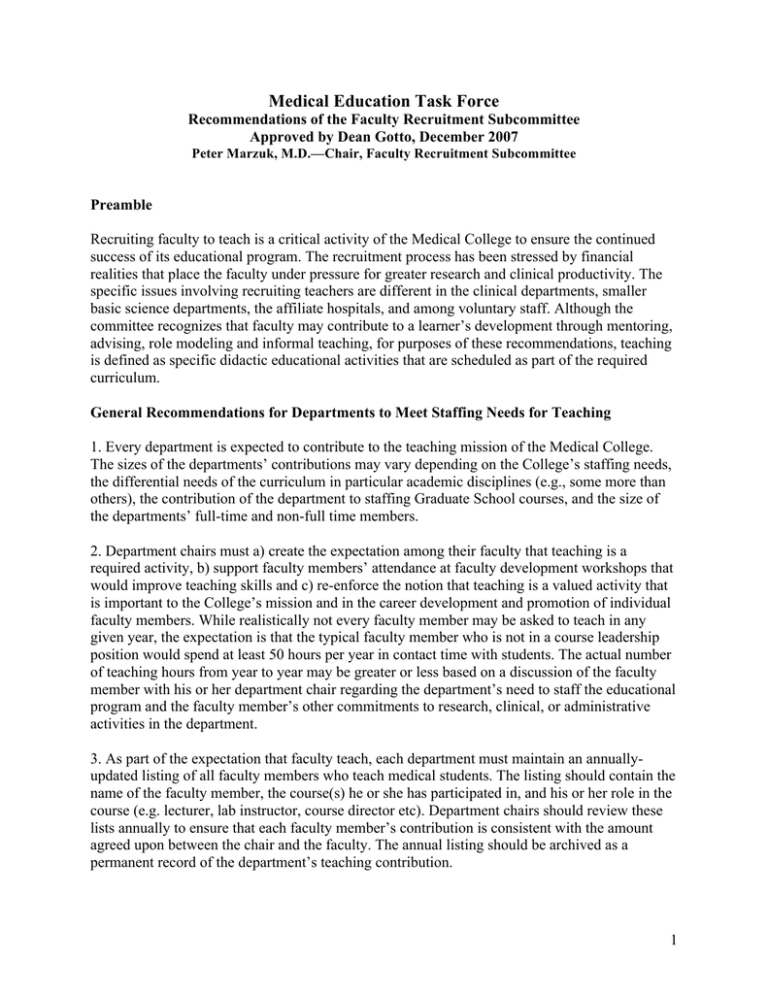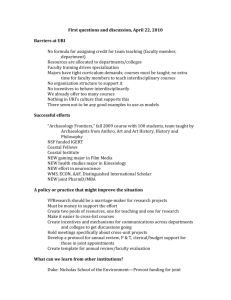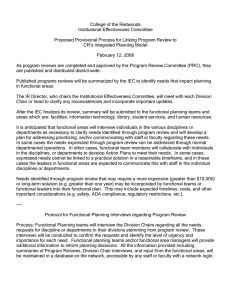Medical Education Task Force
advertisement

Medical Education Task Force Recommendations of the Faculty Recruitment Subcommittee Approved by Dean Gotto, December 2007 Peter Marzuk, M.D.—Chair, Faculty Recruitment Subcommittee Preamble Recruiting faculty to teach is a critical activity of the Medical College to ensure the continued success of its educational program. The recruitment process has been stressed by financial realities that place the faculty under pressure for greater research and clinical productivity. The specific issues involving recruiting teachers are different in the clinical departments, smaller basic science departments, the affiliate hospitals, and among voluntary staff. Although the committee recognizes that faculty may contribute to a learner’s development through mentoring, advising, role modeling and informal teaching, for purposes of these recommendations, teaching is defined as specific didactic educational activities that are scheduled as part of the required curriculum. General Recommendations for Departments to Meet Staffing Needs for Teaching 1. Every department is expected to contribute to the teaching mission of the Medical College. The sizes of the departments’ contributions may vary depending on the College’s staffing needs, the differential needs of the curriculum in particular academic disciplines (e.g., some more than others), the contribution of the department to staffing Graduate School courses, and the size of the departments’ full-time and non-full time members. 2. Department chairs must a) create the expectation among their faculty that teaching is a required activity, b) support faculty members’ attendance at faculty development workshops that would improve teaching skills and c) re-enforce the notion that teaching is a valued activity that is important to the College’s mission and in the career development and promotion of individual faculty members. While realistically not every faculty member may be asked to teach in any given year, the expectation is that the typical faculty member who is not in a course leadership position would spend at least 50 hours per year in contact time with students. The actual number of teaching hours from year to year may be greater or less based on a discussion of the faculty member with his or her department chair regarding the department’s need to staff the educational program and the faculty member’s other commitments to research, clinical, or administrative activities in the department. 3. As part of the expectation that faculty teach, each department must maintain an annuallyupdated listing of all faculty members who teach medical students. The listing should contain the name of the faculty member, the course(s) he or she has participated in, and his or her role in the course (e.g. lecturer, lab instructor, course director etc). Department chairs should review these lists annually to ensure that each faculty member’s contribution is consistent with the amount agreed upon between the chair and the faculty. The annual listing should be archived as a permanent record of the department’s teaching contribution. 1 4. The Senior Associate Dean for Education, in consultation with the course directors, will devise a specific teaching plan to ensure adequate staffing from the Departments to meet all the teaching needs of the curriculum. This plan will, in part, be based on the Senior Associate Dean’s review of the Department’s annual teaching database. The department chair, working with the advice of division directors, program leaders or other department leaders must ensure that faculty who are assigned to teach have the time to be able to participate during the scheduled teaching activity. While faculty absences due to temporary illness or emergency are typically covered by other teachers in a course, the department chair is ultimately responsible for providing a course with a substitute teacher for any faculty member in his or her department who cannot effectively discharge his or her longer term teaching assignment during the course. 5. In general, departments will be asked to staff those specialized educational activities that are relevant to the academic discipline of the department and, by necessity, require the specialized knowledge of faculty experts in their field. In recognition of the fact that the expertise of faculty members is widely variable across departments, upon the request of the Course Director or Senior Associate Dean/designee, department chairs will be asked to identify individuals who are able to contribute the expertise necessary to support the required courses of the curriculum. In general, clinical departments will staff the required clinical clerkships. Basic science and clinical departments will staff specialized learning sessions, e.g. labs, problem solving sessions, case conferences etc. according to the expertise of their faculty members. However, given the interdisciplinary nature of science, chairs should seek to identify faculty with expertise who could teach content outside the traditional academic boundaries of their departments. For example, a faculty member from medicine or pediatrics might have appropriate expertise to serve as a microbiology lab instructor. 6. Clinical departments are expected to provide faculty members to staff learning activities that involve general clinical skills. Examples of such roles include, but are not limited to, office preceptors, physical diagnosis tutors, preclinical course (MPS) small group leaders, and tutors for the clinical skills center activities (standardized patient exercises and simulations). 7. All departments are expected, if asked by the Senior Associate Dean, to provide faculty to staff non-specialized learning activities in the basic science courses such as problem based learning (PBL) and journal clubs. Department chairs should encourage faculty members who have never participated in these venues before to be “apprenticed to” and to serve as “cofacilitators” with faculty members who have experience in PBL and journal club. 8. Course directors, the curriculum office and the Office of Academic Affairs should work collaboratively with department chairs to ensure that courses have the highest quality of teachers possible. To that end, these groups should have ongoing dialogues, as needed, to identify to department chairs those faculty members who perform exceptionally well as teachers. Likewise, these groups will need to provide frank appraisals of faculty members who are not performing well. These faculty members should be encouraged to consult with OCED regarding opportunities for faculty development to assist in improving teaching skills. 2 Recommendations for the Recruitment of Full Time Faculty as Teachers 9. From a practical vantage, not every full time faculty member in a department may be needed to teach to meet a department’s teaching plan obligations. Accordingly, the department chairs should establish their own mechanisms to identify the most competent teachers in their departments for suitable teaching assignments. Department chairs should have a wide latitude in choosing faculty for assignments based on the faculty member’s teaching skills, enthusiasm for teaching, career development, needs for promotion, taking into consideration the faculty member’s other departmental assignments and commitments (e.g., grant deadlines, clinical duties, major projects, teaching obligations to residents, graduate students etc). Ideally, the identified “pool” of competent teachers will be large enough to allow some relief from teaching assignments for a given faculty member from time to time. 10. Faculty who have been newly recruited to a department should be involved in teaching. While department chairs should have flexibility when to assign newly recruited faculty to teaching duties, particularly in the first year following recruitment, there should be no specific statement in a recruitment letter that teaching responsibilities will be automatically waived for a certain time period. Recommendations for the Recruitment of Affiliate Faculty as Teachers The faculty of the WCMC network affiliates are an important and valuable asset to the educational mission of the Medical College. While many such faculty are eager to teach, it must be recognized that added travel time makes a teaching commitment at the WCMC campus difficult. 11. To improve the knowledge of the network faculty about teaching opportunities, each network affiliate should designate a "point person", who would be knowledgeable about the curriculum structure, teaching requirements and course schedules, and who would serve as a liaison among network faculty, the WCMC Curriculum Office, and course/clerkship directors. This role might be served by the associate dean at the network site, a network site department chair or a clerkship director. In addition, the educational leadership of WCMC should make periodic, regular “outreach” visits to the network sites to meet with faculty there about teaching opportunities. Clinical clerkship activities between WCMC-NYPH departments and affiliate sites should be coordinated at the departmental level to ensure compliance with accreditation standards. 12. To incentivize teaching by network-affiliated faculty, the educational leadership at WCMC and the network affiliates should provide faculty with more information about the role of teaching in the academic promotions process, recognize their faculty’s teaching contributions through awards/luncheons/dinners at the network sites, and, whenever possible, develop meaningful incentives, however small, such as offering access to electronic on-line resources or free parking at WCMC. 3 13. To improve the quality of teaching by network-affiliated faculty, the Medical College should provide faculty development programs, whenever possible, at the network sites, and provide network faculty with feedback on their teaching performance. Recommendations for the Recruitment of Voluntary Faculty as Teachers 14. Voluntary faculty members have in the past, and continue, to provide a valuable contribution to the educational mission of the Medical College. Because voluntary faculty are widely dispersed and represent a less formally organized group than either fulltime network affiliated or fulltime WCMC faculty, department chairs should appoint a voluntary faculty member who is, ideally, senior, well-respected, knowledgeable about teaching opportunities and good at ‘networking’ to help recruit voluntary faculty to teaching assignments. 4


